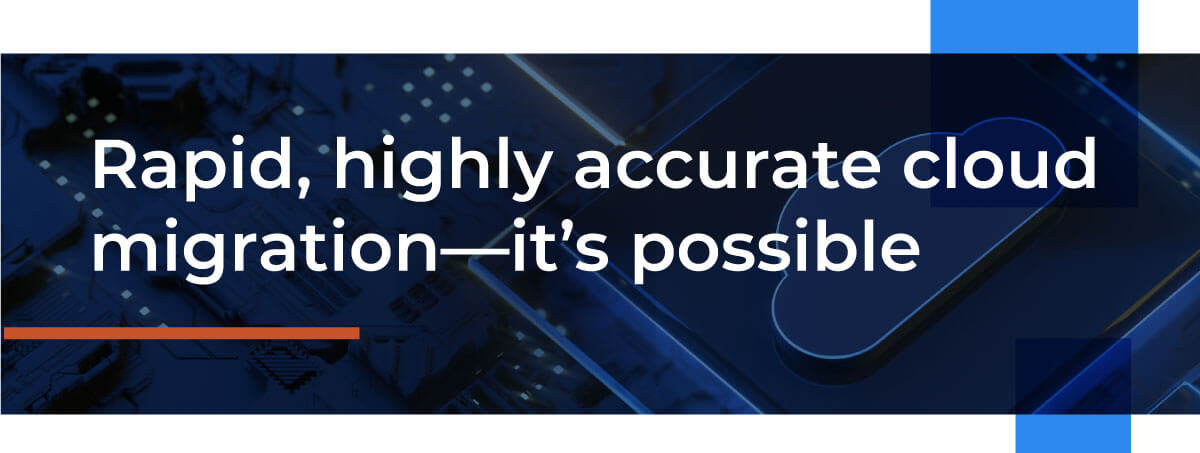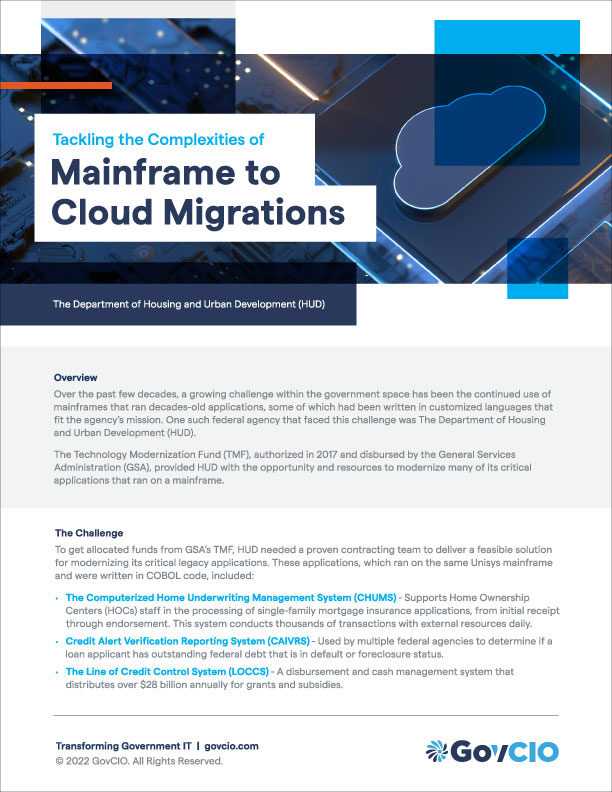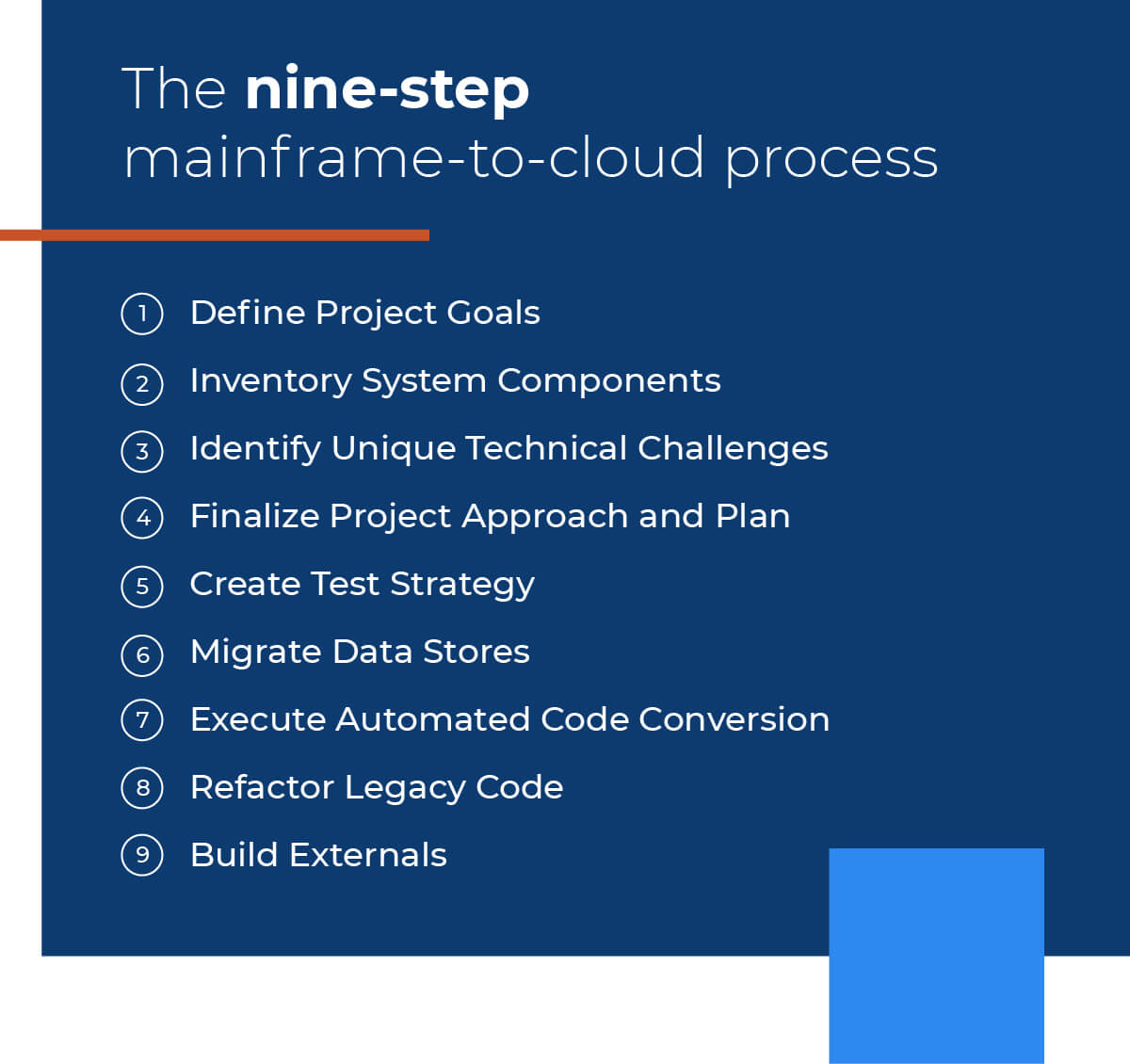Displaying items by tag: government
Ada to C++ US Navy DSR MFIP
The Navy contracted with Digital Systems Resources (DSR), a division of DEC, to modernize the MFIP, so the Mission Computer Upgrade (MCU) program office contacted the U.S. Office of Naval Research (USONR) to identify a viable, cost-effective modernization solution. The USONR recommended that TSRI employ its architecture-driven JANUS Studio® modernization solution. USONR believed this toolset could be the only resource capable of accomplishing the MFIP modernization within schedule, performance, risk management, and cost constraints.
- Customer & Integrator: US Navy & DSR
- Source & Target Language: Ada to C++
- Duration: 5 months
- Services: Application Blueprint®, Transformation Blueprint®, Engineering Support, Automated Transformation
Taking a Low-Risk Approach to Mainframe Modernization — HUD

How do you transform the slow pace of technological innovation within a federal agency into an opportunity for innovation and IT systems modernization? Start by taking a cue from the partnership between TSRI and GovCIO. With backing from the Federal Government’s Technology Modernization Fund (TMF) our joint teams propelled the US Department of Housing and Urban Development (HUD) from an outdated twentieth-century Unisys COBOL system into modern, service-oriented Java that was performant and functionally equivalent.
TSRI worked with GovGIO on their process designed to successfully migrate the applications to the Microsoft Azure cloud. They started by defining the five key project goals and taking an inventory of system components, including intersecting platforms. Once we had identified what the unique technical challenges were and how to address each, we created testing strategies and migrated the data stores for each system. Finally, we executed an automated code conversion and refactored the legacy COBOL code.
TSRI’s partnership with GovCIO executed a rapid, holistic mainframe migration process for HUD that has improved their organizational performance while minimizing risk. On day one after the productions systems were switched over from the Unisys mainframe to the Microsoft Azure cloud, the new system supported 25,356 users and 299,715 transactions with only three user problems reported. These are the HUD systems that manage, store, and protect all the personal financial and employment-related eligibility information for FHA insured financing. Given the criticality of the data managed every day by HUD, it was important that the migration run without impact on operations. The result could be seen in the first 30 days during which the new system disbursed just over $2.7 billion dollars in HUD program funds without a single error.
 Review the details of how TSRI and GovCIO successfully executed this complex modernization project in our recently published case study.
Review the details of how TSRI and GovCIO successfully executed this complex modernization project in our recently published case study.
The 9 Low-Risk Steps That Led to Success
You might be surprised that HUD and other government agencies still run their IT on mainframes using COBOL (first released in the 1950’s), or MUMPS (from the 1970’s). Running on these aging platforms presents an extensive list of challenges to these agencies: data management, growing storage, collaboration, security, etc. The modernization process typically involves risk, time, and significant expense. It’s understandable that a large agency like HUD would want to select a partner they knew could deliver a low-risk, high-accuracy result.
Working together, we adhered to GovCIO’s nine-step best-practices process that resulted in modernizing systems to modern cloud architectures that can now evolve with HUD, while preventing negative impacts to their mission, day-to-day operations, and security.

For more details on the nine-step process that enabled HUD to enter the cloud age, read our latest white paper with GovCIO.
A first-person account of HUD’s modernization process with Roger Knapp – Executive Vice President and HUD Program Manager
Only a few engineers know what it feels like to lead a major government agency through an automated mainframe modernization. Roger Knapp is one of them and has been working in the field for over 30 years. As Executive VP of Engineering & Service Delivery at TSRI, Roger has unique insights on the HUD project. He sat down to share them in an interview with GovCIO as part of their Partner Spotlight.
In a short chat, he shares how the TSRI-GovCIO team overcame the challenges not only of modernizing a nationally mission-critical system at risk of obsolescence, but also how to deal with the presence of dynamic SQL data in the legacy application logic.
Get the story straight from Roger in his interview with GovCIO.
TSRI is Here for You
As a leading provider of software modernization services, TSRI enables technology readiness for the cloud and other modern architecture environments. We bring software applications into the future quickly, accurately, and efficiently with low risk and minimal business disruption, accomplishing in months what would otherwise take years.
Ada to C++ - US Navy - Modem Control Software
TSRI was engaged to modernize US Navy SATCOM Multi-band Terminal (NMT) Modem Control System (MCS) from Ada to C++. To provide SPAWAR with the best modernization approach, Raytheon selected TSRI to transform the existing MCS Ada code into C++ and to re-factor
the C++ toward the desired target architecture. TSRI's fixed-price "integrator ready" deliverable was selected by Raytheon for its low technical risk,
shortened schedule, and low cost.
- Customer & Integrator: US Navy & Raytheon
- Source & Target Language: Ada to C++
- Lines of Code: 190,000
- Duration: 5 months
- Services: Automated Code Transformation, Application Blueprint®, Transformation Blueprint®, Engineering Support, Automated Refactoring
New Book by Ulrich and Newcomb
|
"New Book by Ulrich and Newcomb: Information Systems Transformation: Architecture-Driven Modernization Case Studies with |
Kirkland, WA. (Feburary 22, 2010) – Book Release Information Systems Transformation: Architecture-Driven Modernization Case Studies Information Systems Transformation: Architecture-Driven Modernization Case StudiesBy William M. Ulrich and Philip H. Newcomb Published by Morgan Kaufmann ISBN: 978-0-12-374913-0 Copyright Feb 2010 $59.95 USD €43.95 EUR £29.99 GBP www.informationsystemstransformation.com |
| What The Experts Are Saying: According to Grady Booch, IBM Fellow & Chief Scientist, Software Engineering: "Ulrich and Newcomb's book offers a comprehensive examination of the challenges of growing software-intensive systems … (Read more...) According to Ed Yourdon, noted Author and Consultant: "Modernization is going to be a more and more important part of the overall IT strategy. William Ulrich and Philip Newcomb's important new book ... (Read more...) According to Richard Soley Ph.D. Chairman/CEO, Object Management Group (OMG): “Estimates by internationally-known researchers of the worldwide legacy code base is now approaching a half-trillion lines. That only counts so-called "legacy languages" like COBOL--which drive the world. Add in database schemas … (Read more...) About the Book Information Systems Transformation: Architecture-Driven Modernization Case Studies, a new book by William Ulrich and Philip Newcomb, provides a practical guide to organizations seeking ways to understand and modernize existing systems as part of their information management strategies. It includes an introduction to ADM disciplines and standards, including alignment with business architecture, as well as a series of scenarios outlining how ADM is applied to various initiatives. Ten chapters, containing in-depth, modernization case studies, distill the theory and delineate principles, processes, and best practices for every industry, ensuring the book's leading position as a reference text for all of those organizations relying on complex software systems to maintain their economic, competitive and operational viability. (Read more...) Key Features
|
William M. Ulrich is President of Tactical Strategy Group, Inc. (TSGI) and a management consultant. Mr. Ulrich has been in the modernization field since 1980 and continues to serve as a strategic advisor on business and IT transformation projects for corporations and government agencies. In 2005, Mr. Ulrich was awarded the Keeping America Strong Award for his work in information systems modernization. He is Co-Chair of the OMG Architecture-Driven Modernization Task Force and the OMG Business Architecture Special Interest Group, Editorial Director of the Business Architecture Institute, and author of Legacy Systems: Transformation Strategies. and a management consultant. Mr. Ulrich has been in the modernization field since 1980 and continues to serve as a strategic advisor on business and IT transformation projects for corporations and government agencies. In 2005, Mr. Ulrich was awarded the Keeping America Strong Award for his work in information systems modernization. He is Co-Chair of the OMG Architecture-Driven Modernization Task Force and the OMG Business Architecture Special Interest Group, Editorial Director of the Business Architecture Institute, and author of Legacy Systems: Transformation Strategies. |
Philip H. Newcomb is Founder and CEO of The Software Revolution, Incorporated (TSRI) and creator of TSRI's acclaimed architecture-driven modernization services and toolset JANUS Studio®. He is coauthor of Reverse Engineering (Kluwer 1996) with Linda Wills, Coeditor of the 2nd Working Conference on Reverse Engineering (IEEE 1995) with Elliot Chikofsky and principal author of the Abstract Syntax Tree Metamodeling Specification (OMG Specification 2009). With more than 35 publications and 70 successfully completed information system modernization projects he is a recognized leader in the application of artificial intelligence, automatic programming and formal methods to industrial-scale software modernization. and creator of TSRI's acclaimed architecture-driven modernization services and toolset JANUS Studio®. He is coauthor of Reverse Engineering (Kluwer 1996) with Linda Wills, Coeditor of the 2nd Working Conference on Reverse Engineering (IEEE 1995) with Elliot Chikofsky and principal author of the Abstract Syntax Tree Metamodeling Specification (OMG Specification 2009). With more than 35 publications and 70 successfully completed information system modernization projects he is a recognized leader in the application of artificial intelligence, automatic programming and formal methods to industrial-scale software modernization. |
| About Morgan Kaufmann: Since 1984, Morgan Kaufmann has published premier content on information technology, computer architecture, data management, computer networking, computer systems, human computer interaction, computer graphics, multimedia information and systems, artificial intelligence, computer security, and software engineering. Our audience includes the research and development communities, information technology (IS/IT) managers, and students in professional degree programs. Learn more at www.mkp.com. Contact Bob Dodd, 781-313-4726 or This email address is being protected from spambots. You need JavaScript enabled to view it., for an electronic review copy, access to our expert authors, or to publish excerpts of our material. For more information about TSRI contact: TSRI Greg Tadlock Vice President of Sales Phone: (425) 284-2770 Fax: (425) 284-2785 This email address is being protected from spambots. You need JavaScript enabled to view it. |
- 2010
- 2770
- 284
- 2842770
- 2847
- 2nd
- 313
- 374913
- 425
- 425284
- 4726
- 781
- 978
- about
- abstract
- acclaimed
- according
- acts
- add
- adm
- advisor
- agencies
- alignment
- allowing
- america
- application
- applied
- apply
- approaching
- architecture
- artificial
- audience
- author
- authors
- automatic
- award
- awarded
- base
- been
- bob
- booch
- book
- Business
- called
- case
- ceo
- chair
- chairman
- challenges
- chapters
- chief
- chikofsky
- coauthor
- cobol
- coeditor
- com
- common
- communities
- competitive
- complete
- completed
- complex
- comprehensive
- concepts
- conference
- consultant
- contact
- containing
- content
- continues
- copy
- copyright
- core
- corporations
- countries
- counts
- covering
- creator
- database
- degree
- delineate
- depth
- development
- different
- director
- disciplines
- distill
- dodd
- Drive
- economic
- editorial
- electronic
- elliot
- elsevier
- engineering
- ensuring
- eur
- every
- examination
- examples
- excerpts
- expert
- experts
- feb
- feburary
- fellow
- field
- fletcher
- force
- formal
- founder
- four
- gbp
- getting
- going
- government
- grady
- graphics
- greg
- group
- growing
- guide
- half
- has
- his
- how
- human
- ibm
- ieee
- illustrated
- immediately
- implementing
- important
- includes
- including
- incorporated
- industrial
- industries
- industry
- information
- informationsystemstransformation
- initiatives
- institute
- intelligence
- intensive
- interaction
- interest
- internationally
- introduction
- isbn
- janus
- kaufmann
- keeping
- key
- kirkland
- kluwer
- known
- languages
- Leader
- leading
- learn
- legacy
- life
- like
- linda
- lines
- maintain
- management
- managers
- marketing
- material
- metamodeling
- mkp
- models
- modernization
- modernize
- more
- morgan
- multimedia
- multiple
- networking
- newcomb
- noted
- offers
- omg
- one
- only
- operational
- organizations
- outlining
- overall
- part
- philip
- platforms
- position
- practical
- practices
- premier
- president
- principal
- principles
- processes
- professional
- programming
- programs
- projects
- publications
- publish
- published
- real
- recognized
- reference
- release
- relying
- research
- researchers
- results
- reverse
- review
- reviews
- revolution
- richard
- sales
- salesteam
- saying
- scale
- scenarios
- schemas
- scientist
- security
- see
- seeking
- series
- serve
- services
- shopping
- since
- site
- softwarerevolution
- soley
- solutions
- special
- specification
- standards
- started
- stop
- strategic
- strategies
- strategy
- strong
- students
- studies
- successfully
- system
- tactical
- tadlock
- task
- technology
- ten
- tested
- text
- than
- their
- theory
- those
- tim
- timothy
- toolset
- transformation
- trillion
- trsi
- tsgi
- tsri
- ulrich
- understand
- usd
- various
- viability
- vice
- visit
- was
- Ways
- web
- well
- what
- which
- william
- wills
- work
- working
- world
- worldwide
- www
- yourdon
Government Modernization Breaks Loose
During the past two months Federal government modernization has gained steam--first with the Administration’s modernization plan, released for comment at the end of August, followed by final movement on the critical Modernizing Government Technology (MGT) Act which gained Senate approval on September 18.
